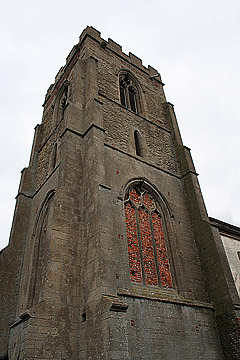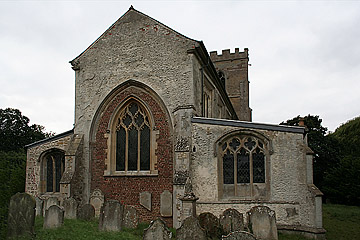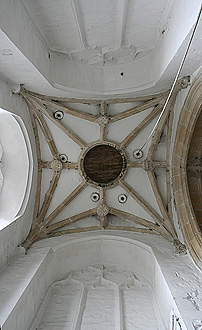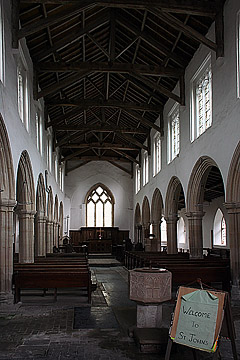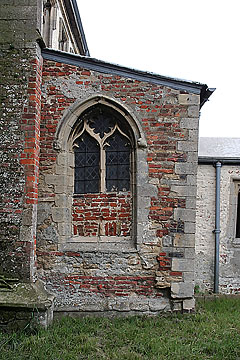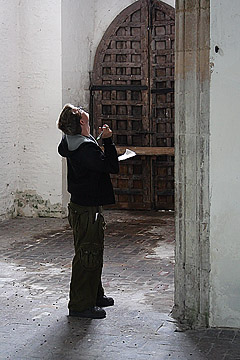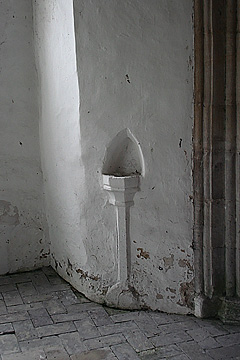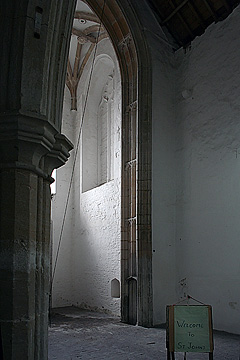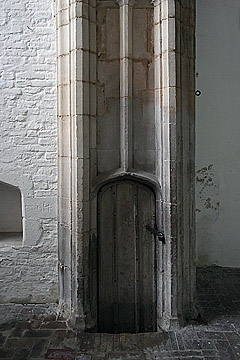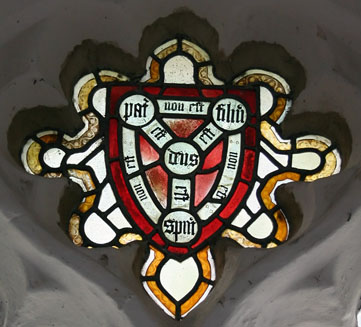St John is a fine and ancient building, but was only an active parish church for just over a hundred years. Originally, it was built as a chapel of ease to the church at Leverington. Chapels of ease are quite common in the fens, where medieval settlements were of necessity rather small and far-flung.
The chapel was an outpost of the mother church, and services would be conducted in the former for those parishioners who would find it too difficult to travel to the latter. Initially, the mother church retained the rights for the serious sacraments like baptism and marriage, but in some places - like Parson Drove - these were gradually wrested away from the mother parish.
St John was made a parish church in its own right in 1870, at a time of big population growth in the fens. So big was the growth that they almost immediately built a second church in the village - Emmanuel Church, about a mile down the road. Alas, its new neighbour eventually rang the death knell for St John: by 1974 there was no longer any need for two churches here, and (madly, in my view) the more convenient location of the Victorian church led to its being retained and St John's being made redundant. It is currently in the care of the Churches Conservation Trust.
Despite their subordinate status, chapels of ease were quite frequently splendid buildings, and not in the least inferior to a parish church. The most wonderful example I know of in this part of the world is St Nicholas in King's Lynn: right up until it too was made redundant it was still just a chapel, despite being a vast Perpendicular barn full of glass and hammerbeams. St John is not quite on that scale - but it is still rather fine. This is a large building, mostly Perpendicular in style. Originally it would have been even larger, but the chancel (which stretched an extra 34 feet to the east) was washed away in a flood in 1613.
The patched-up remains sit in an overgrown churchyard looking dignified but a bit shabby. The finest part of the building is the 70 foot west tower, which is faced in smooth Barnack stone and is decorated with a parapet dotted with gargoyles.
Big three-light windows fill the second stage of the tower, though the north- and south-facing ones are bricked in. A stair turret rises in the noth-east corner, and the medieval doors survive in the west doorway.
The rest of the church is long and low, and dominated by the prominent Perpendicular clerestory and its large square-headed windows. Some of the windows in the south aisle have been horribly restored. The rebuilding was quite necessary - the precipitous lean of the medieval window in the east window of the aisle tells us something of what must have happened here - but who on earth thought that wooden y-tracery would look good in a building like this? That aside, however, it's a charming picture.
The church is entered through a little porch, also of the 15th century, which has an original tie-beam roof. Stepping inside, the first thing I noticed was the tang of ammonia in the air. St John is now home to the largest colony of brown-eared bats in the county, and they make their presence felt in the smell on the air and the small piles of poo on the floor. Not that I object in the slightest: bats are magnificent creatures, and it is nice that the church is filled with a busy congregation of some sort.
The second thing that I noticed was the amazing tower arch. It is very elaborate and tall: strangely so, since (if I read the history correctly) its full height wouldn't have been seen before the nave roof was raised after a gale in 1865.
The arch is decorated with blind panelling along the inner faces. I especially liked the little door in the base of the north respond, the oak of which has faded to the same silvery colour as the stone. The tower space itself is roofed by a stone vault, possessed of little bosses which include a very fierce head, and crowned with a wide circular opening for the bell-ropes.
As the exterior suggested, most of the church is 15th century. There are some earlier fragments - the north doorway inside its shallow porch is from 1220, and there are some 14th century windows in the north aisle - but the rest is more or less of a piece.
The nave is six and a half bays long (though now seems somewhat shorter due to the easternmost bits now being used as a chancel). It is decent crisp Perpendicular stuff, though less showy than the tower space. The piers of the nave arcades are in the form of clusters of smaller shafts, and above them the broad clerestory flood the church with light. The roof was restored in the 19th century, but they retained the 15th century tie beams.
In common with most CCT churches, St John is rather bare of interesting furnishings. However, there are some things worth picking out. The 15th century font is octagonal and has shallow carving on the bowl. The pulpit is a nice bit of 17th century wood carving: the guidebook suggests that it dates from 1637. To its east, the relocated sanctuary is marked out with Victorian screens. The east window dates from 1895, and sits in the old chancel arch: a sad reminder of its former function is given by the old rood stair which sits to the north of the window.
Finally, and rather surprisingly for a building with such a chequered history, there is some good medieval glass remaining in the last three north windows. Each contains a fragment with a shield: one depicting the Trinity, one depicting three chalices and wafers, and one depicting the three crowns of the diocese of Ely. They have clearly been reset, but they're still nice survivals.
St John is kept locked, but there is clear information about keyholders.
|
|||
